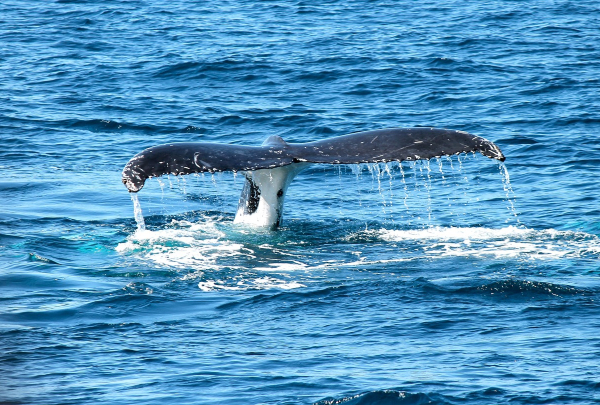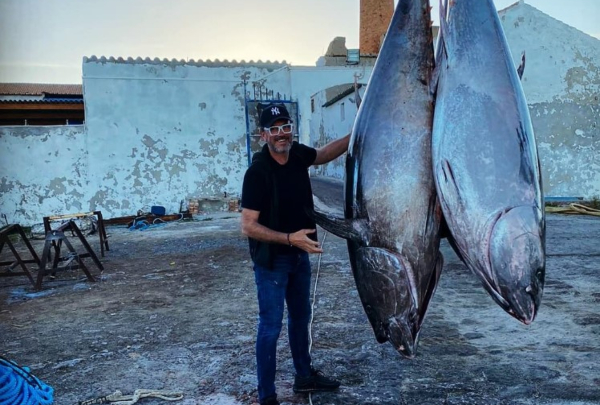Interview
Ralph Chami: “A service that captures carbon from a live whale is worth much more than the meat of a dead whale”

A dream come true can be much more than that, and can unleash a spiral that leads an expert in macrofinancial issues, a former International Monetary Fund employee, to rethink his professional future and suddenly veer his rudder to become an activist and a protector of nature.
For Ralph Chami, the simple desire to see a blue whale gave him a new focus of the world and what we could do for it. That was when he started work and developed a model to evaluate natural capital - including blue and green nature, and also flora and fauna - and a framework to develop ecosystemic services' natural capital markets. With Chami, the figures move out of lecture theatres and offices to move into wild territory. Let's take a look at how they behave in this territory with Ralph Chami, financial economist and co-founder of Blue Green Future and Rebalance Earth, organisations in which a number of professionals from the economic world place their knowledge at the service of nature in order to bring about a more sustainable future.
Our usual concept of economics and environmental protection is that they are diametrically opposed. What leads a financial economist working at the International Monetary Fund (IMF) to become an environmental activist?
In 2017, I realised my dream of observing whales, sailing with experts in large cetaceans, who were studying these whales in the Sea of Cortés. On my first day I spied the most magnificent being I have ever seen: the blue whales, the largest creature that has ever existed (...). I learned from these scientists that the whales capture so much carbon in their bodies and indirectly through fertilisation of phytoplankton. As I was working at the IMF, and at the time my institution was trying to mitigate climate change and calculating the optimum price of carbon, I realised that these whales are huge allies in the fight against climate change. Not only are they intrinsically beautiful creatures, but also, because they live for themselves, they are helping to save us from climate change. And so I asked myself this question: "I work for the IMF and they pay me a salary for my services. How much should we pay the whale for its services? In this case, for capturing carbon on behalf of humanity?" And that started the ball rolling. We wrote out the initial piece to answer this question and describe how to protect the whale for itself, and for it to go on taking care of us.
And from whales to elephants. What did you discover about them?
Then, Fabio Berzaghi, the elephant scientist, who had realised that elephants also help to sequester carbon in the forests of the Congo basin, called me and asked me to help save them from poachers. Together, with Fabio, we valued the services of elephants in terms of carbon sequestration. We posted this, and we were asked to value seagrass. Other requests then started to come in to assess the ecosystemic services of other natural assets.
But the main theme in all this work is that we are valuing the services of living nature, not dead nature. This was a Eureka moment for me. Live healthy nature is worth much more than dead nature. A service that captures carbon from a live whale is worth much more than the meat of a dead whale. A live elephant, which lives for itself, provides a carbon sequestration service that is economically much more valuable to humanity than the tusk of a dead elephant. In terms of carbon capture, fish populations and flooding control, live seagrass has an immense value for humanity, much more so than replacing seagrass with a marina!
This realisation changed everything for me: the fact that the intrinsic value of living nature is also invaluable from the financial perspective for our society and our economy. So we should change our mindset and move on from an extractive view of nature to a different kind of view focusing on regenerative nature.
So the economy should be at the service of nature?
Put simply, if nature dies, we die. If nature is stressed, our lives will be stressed, and so will our economies and societies. Nature is our home. If our home is not protected and maintained, we can't protect ourselves against wind and rain. In the language of economics, nature is macrocritical.
What are the benefits of introducing the language of money into conservation?
Until this work was carried out, conservation was seen as a cost proposition. Think about it: on an individual basis, at Christmas you get asked to finance the protection of cheetahs, elephants, bonobos, lions, whales, parks etc. Companies see conservation contributions as cost plans which help their public image. Governments see conservation as a necessary fiscal drain, because conservation is a public duty, and private individuals will never offer enough money to cover the costs of protecting nature.
Now, enter our new paradigm based on nature, in which a live elephant, a rhinoceros, a whale, a mangrove, seagrass etc. are valuable assets that provide a monetary value for their services. In this way, conservation has ceased to be a cost proposition and bas become an income proposition. As it has ceased to be a cost proposition, conservation becomes a welcome activity, because we are preserving and protecting an asset that provides monetary value, in addition to its intrinsic value.
How were the carbon offsets calculated?
We developed a new methodology I've called "science-based finance". We began with an understanding of the physiology of the natural system - seagrass, elephants, whales, mangroves etc. Then, on the basis of their characteristics, we and the scientific experts required built non-linear models to enable us to project the future quantities of carbon sequestered by the system. We did this with whales, elephants, seagrass, mangroves etc.
You argue that countries could sell their carbon dioxide capture offsets. Who would buy the carbon offsets?
At the Paris Agreement in 2015, countries undertook to reduce their carbon emissions to zero, neutral or negative by a certain date, focusing particularly on the year 2050. Businesses then undertook to do the same. That's where the demand comes from. As the time comes to move above 1.5 degrees centigrade, demand for a carbon-sequestering technology is soaring, and this is borne out by the price of a metric tonne of carbon. Some businesses are paying out 1,200 dollars per tonne of carbon captured by a machine. But the only reliable technology which goes back 4 thousand million years and can do this and help mitigate climate change by at least 37% is Living Nature.
Do you think that companies will pay for this voluntarily, or should governments create taxes?
People, investors and businesses will be attracted by the new economy for a number of reasons. Some will pay out because they are altruistic, philanthropic and ethical, believing in the prosperity of nature living for itself. Others will pay out because Living Nature is now an invertible proposition that will generate revenue for them and for the administrators of nature. Also, now that natural systems have been transformed into natural assets, they generate revenue for governments. Governments would therefore be more than keen to protect and securitise nature.
Taxes are applied when conservation is a cost proposition and a public asset. Invariably, individuals and private organisations attempt to arbitrate taxes to reduce what they actually pay. Both these characteristics are no longer true when we build an economy on the basis of living nature. Firstly, nature becomes a revenue generator instead of a cost. Secondly, individuals and businesses would be delighted to pay out for this because they obtain private benefits from living, healthy nature.
From what you say, I surmise that it is possible to build an economy which operates on the basis of nature.
Exactly, that is the only possible way forward. The problem we face at the present time with climate change, the death of nature and the loss of biodiversity is caused by the belief that we can build an economy outside nature. That’s totally wrong, and we're paying the price of this self-inflicted wound. The paradigm we're helping to develop focuses on nature and people.
On the subject of people, what would the effect of this transaction be on the indigenous population?
The very design of this new paradigm makes it positive for nature and people. The new nature-based economy is design-constructed on protection of nature and of its administrators in perpetuity. Are you wondering why? Well, because only living prosperous nature can guarantee carbon. Therefore, anyone who possesses the natural asset or speaks on its behalf will have to protect the asset so that it continues to produce carbon on behalf of anyone who has bought the carbon credits. Secondly, experience has shown that things only go well for nature when things go well for its administrators. The administrators are the indigenous populations and local communities. If things don't go well for them, things won't go well for their natural surroundings either. Also, when we create resilience in nature, we create resilience in people, and we stabilise them in their local habitats. And so, in this new world everyone wins: the buyer of biodiversity or carbon credits, the seller of the credits, Nature will also reap the benefits, and so will indigenous peoples.
















